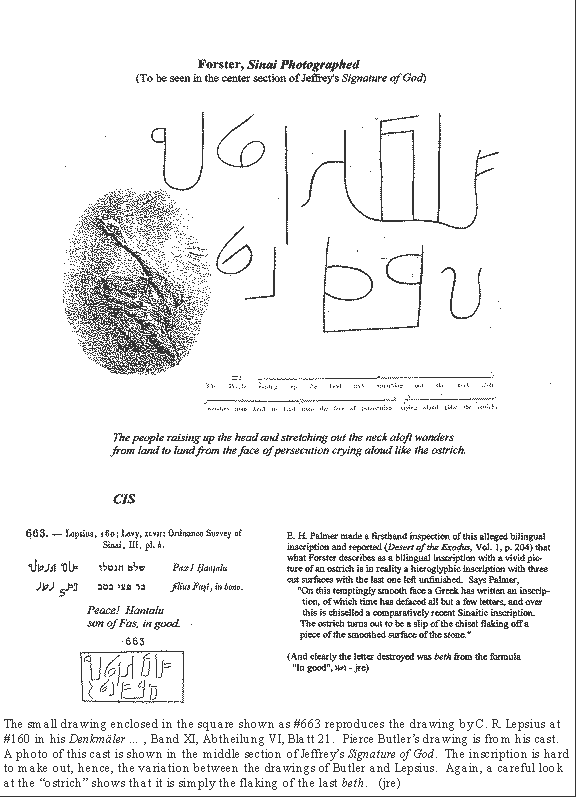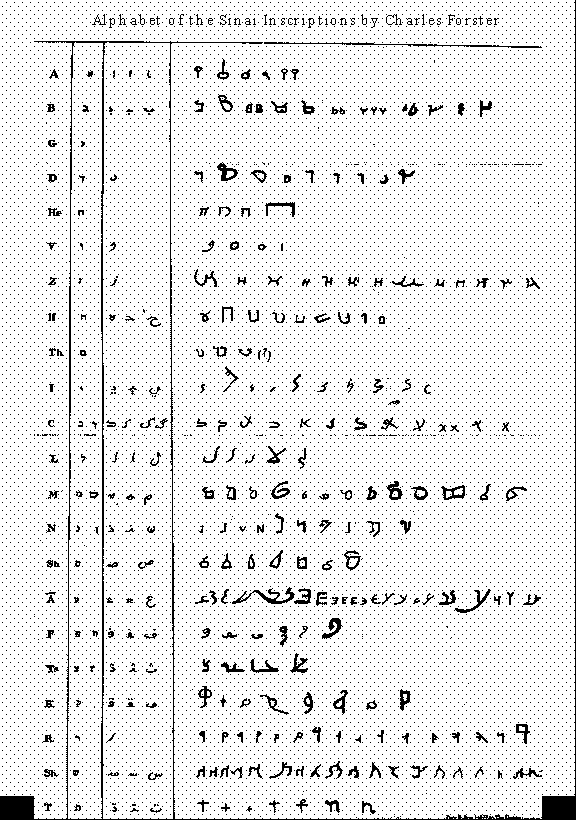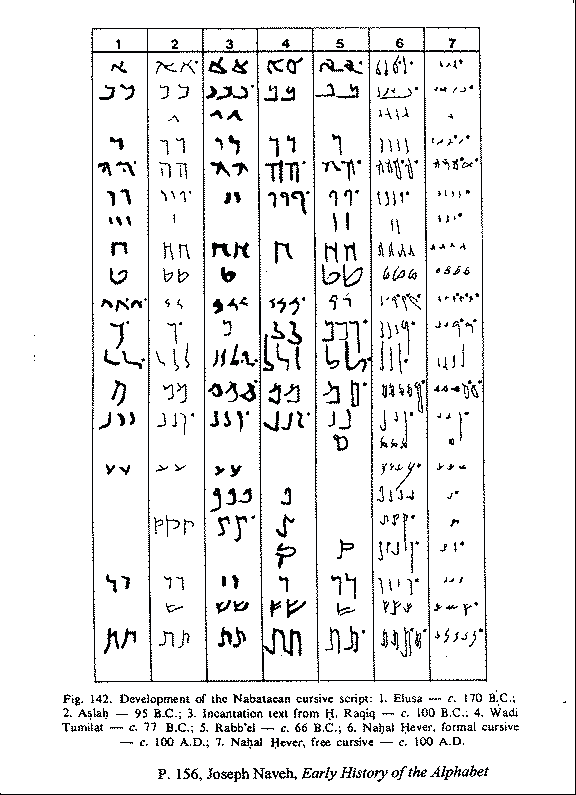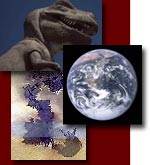| Site Map | Contacts | Links | Newsletter | |
The Bible and Science:
Verifying the Signature of God
(What About Those Nabataean Inscriptions?)
© John Eccles.2000
It was exciting to see Josh McDowell’s Evidence that Demands a Verdict when it was first released in 1972. Thorough footnoting and strong, if brief, bibliographies meant that Christians would have a valuable tool to help them build a case for Christianity amongst their friends and fellow-students. In a book of this kind, they would find an excellent starting place to build papers and presentations offering a rational presentation of the Christian faith and message.
In recent years, a new and different kind of Christian apologetic literature has appeared in Christian marketing channels, books that seek to show the existence of God and the reliability of the Scriptures by employing “spectacular” findings and that present evidence which, while intriguing, simply does not always find a base in facts which can be proven. This new material needs to be classed somewhere at the level of the National Inquirer or other “supermarket tabloids”. The material included in these new books that allegedly are put forth in order to defend the truth of God is now often written to create an aura of the spectacular and the basis in truth seems often to be secondary. Somehow theory is now, at the turn of the millennium, being offered as fact. Often the assertions set forth in these publications contain either false statements or border on half-truths. Old questionable theories are revived as though they were long lost demonstrations of truth.
To cite one example, Grant Jeffrey’s The Signature of God begins with a focus on the work of an Irish prelate, Rev. Charles Forster, who published several texts nearly a century and a half ago. Among these publications that appeared in England is the two volume The One Primeval Language with the first volume subtitled The Voice of Israel from the Rocks of Sinai (1851) and the second volume (1853) subtitled The Monuments of Egypt. They were followed in 1862 by Sinai Photographed, which discussed and offered translations of both Egyptian hieroglyphics and the alphabetic inscriptions on the rocks of the Sinai. Forster carried forth an earlier theory that these writings were left there by Moses and the Children of Israel as they made their way out of Egypt during the Exodus. Forster offers translations of much of this material, translations that he says indicate these writings were put on the rocks by the Israelites and reflect highlights of the Exodus experience.
The Reverend Jeffrey was able to secure a copy of Sinai Photographed and has popularized Forster’s work in his 1996 “best selling” Signature of God, a book which has been widely marketed.
It was as though Grant Jeffrey had given us a valuable link to some long lost scholarship. The inscriptions are there in the rocks of the Sinai by the thousands and they have been well cataloged. Michael Stone was responsible for the three volumes of the Rock Inscriptions and Graffiti Project issued in 1992 by Scholars Press, Atlanta, GA.
If indeed the Children of Israel had scratched or chiseled these inscriptions into the rocks of Sinai, then that would certainly be an amazing find.
Forster was among the first, though not the first, to put forth translations of this material. But were these translations reliable. Grant Jeffrey states, “…to my knowledge, no one has produced any alternative translation of the inscriptions as evidence that anyone else produced them.” This statement was made in his 1996 The Signature of God, p. 68. On this same page, he says, “Three scholars, Professor de Laval, Niebuhr and Forster have independently translated these fascinating rock inscriptions.” True, Forster did make his very original, and erroneous, translations. But not Lottin de Laval, who was a “documentary reporter” and a “documentary illustrator”, nor Niebuhr who did not attempt translations of either the Sinai rock writing or the Egyptian hieroglyphic inscriptions. The translations of Niebuhr’s hieroglyphic plates to be seen in Sinai Photographed were made by the Rev. Forster. Incidentally, Forster’s method of working out translations for the Egyptian inscriptions can be seen in The Monuments of Egypt which is the second volume of The One Primeval Laguage (1853) in which he charts his own translation pathway, the work of earlier Rosetta Stone scholarship notwithstanding.
As for Lottin de Laval, his credentials lie in the area of documentary books, not scholarship in Semitic languages. Publications credited to him include, to give one among many, Andalousia, la perle des Andalouses. It was Charles Forster himself who produced the “decipherments” of many of de Laval’s pictures of the Sinai inscriptions.
“The Sinaitic inscriptions are here presented to the Christian reader for the first time, deciphered, not from copies, but wholly from casts and photographs of the originals.” (Sinai Photographed, p. 150). Then he states that he is the one who is undertaking the decipherment of de Laval’s inscriptions (op. cit., p. 154). Clearly, de Laval simply recorded them in an accurate way. Neither Niebuhr nor de Laval made independent translations as Grant Jeffrey affirms. Neither were Semitic scholars, although most of the nineteenth century explorers could handle Arabic well.
There are some misquotes to be found in The Signature of God which indicate that Grant Jeffrey did not check the sources. This could be called “single-sourcing” At p. 63 of The Signature of God, Jeffrey assigns the authorship of a book titled Biblical Researches to Niebuhr. In fact, the author of the text is another explorer and traveler of the nineteenth century, Edward Robinson. Surely there is a greater likelihood of arriving at the truth of a matter when several research sources are employed. Rev. Jeffrey, in the main, has confined his research concerning the Sinai inscriptions to the pages of Forster’s Sinai Photographed. A look at Forster’s work reveals that there are some misquotes taken from Sinai Photographed. It is Carsten Niebuhr, not his son Barthold, who did the exploring Page 63 of his book shows that Jeffrey somehow got hold of the wrong name. In fairness, Rev. Jeffrey did seem to get ahold of a key source, Lottin de Lavel’s Voygage dans la Péninsula arabique du Sinai et l’Égypte moyenne, however, his quotes do not apply to the actual translation of the inscriptions.
Charles Forster, whose work is “re-surfaced” in The Signature of God, had ample alphabet source materials to attempt translations of the rock writing. The large (approximately 2’ by 3’) chart of primitive language characters (titled A Harmony of Primitive Alphabets) which Forster himself had compiled contains samples of both the Phoenician alphabet and a crude Nabataean alphabet.
Instead of using or modifying the available alphabets, Forster chose to strike out on his own. The frequent three letter greeting translated “salam” (Hebrew, “Shalom”) he takes to be a two letter word meaning “people”. The letters beth, tau, beth that often appear at the end of a memorial inscription meaning, “in good”, Forster takes to read “IAO”, or “JAH”, shortened from “JAH” (“Jehovah”). From assumptions of this kind he builds his own unique alphabet, an alphabet that has many optional forms. Any attempt to recreate his alphabet from his work in Sinai Photographed is impossible. There are too many varying forms for many of the letters. In an earlier publication, A Harmony of Primeval Alphabets, Forster had shown twenty different forms for the letter ayin. His alphabet leaves much “wiggle room”.
Eduard F. F. Beer, a capable but short-lived German professor (he passed on at the age of 38), had earlier (1840) built a correct alphabet from these inscriptions, though he did little actual translation. Forster demeaned his work, though Beer was later justified by the careful work of Julius Euting (1891) and others. (See their alphabets in the Appendix.)
Forster’s method is to transliterate many of the Sinai inscriptions into Arabic characters and then to “translate” them using an Arabic lexicon, but, with little regard for the Arabic verb system with its ten forms. The inscription pictured on page 54 of The Signature of God has the translation, “The wind blowing, the sea dividing into parts, they pass over.” The Corpus Inscriptionum Semiticarum (usually designated as “CIS”) offers as a translation the single Nabataean name, “Almabaqaru”.
From a few words that he finds in each line of an inscription, he proceeds to build, in a paraphrase fashion, both narrative and poetic statements. One is reminded of Ken Taylor’s vivid translations in The Living Bible.
| The literal Arabic words: | “they pass over” | “distribute” | “water” | “air” |
| Forster’s Translation: | “they pass over” | “dividing into parts” | “the sea” | “the wind blowing” |
The authors of the voluminous Corpus Inscriptionum Semiticarum pronounced Forster’s work to be “silly” and Edward Robinson calls it “visionary” in his Biblical Researches in Palestine…(1874).
What then are these mysterious writings on the rocks of the southern part of the Sinai Peninsula? In point of fact, there is a mixture, a mixture that reflects the ongoing history of the various peoples that traversed the Sinai from about 1500 B.C. through the Crusades and later. There are inscriptions in what can be called, “Proto-Sinaitic”. There are Egyptian hieroglyphic writings. There are also inscriptions in Nabataean, Arabic, Latin, Greek, Armenian, Georgian and Arabic in its more modern script form. There is also a sprinkling of tourist or pilgrim markings in modern European languages.
The inscriptions dealt with by Forster, aside from his treatment of Egyptian hieroglyphics, are, in fact, the products of the Nabataean civilization, a civilization that flourished many centuries after the Exodus.
In the Sinai these rock inscriptions are widespread, and the Nabataean inscriptions are clustered in places like Wady Mukattub, Wady Maghara, and other sites. They are indeed in the route of the Israelites coming out in the Exodus. However, the inscriptions are also found along the west side of the Gulf of Aqaba, in the remains of storied Petra, and on the edge of the desert roughly east of Galilee.
The inscriptions which Forster assigns to the Israelites have been clearly shown to be Nabataean, the language of the Arabians who ranged from Sinai and around the perimeters of Palestine and whose kingdom and culture flowered in the era of the Roman occupation: 100 B.C. through ca. 200 A.D.
Nabatean is a language that reflects a significant Aramaic influence. The word “BAR”=”son” appears often. The script itself became a forerunner for the modern Arabic script. Beatrice Gruendler displays the development of this script in her The Development of the Arabic Scripts. (1993)
Grant Jeffrey in stating that he was not aware of other translations of this material should have done more extensive research. Some examples of other translations follow, translations that differ greatly from those of Forster.
The “ostrich” inscription shown in Jeffrey’s center photo section is CIS #663, where the translation is shown to be,
“Peace, Hantalu
son of Fas, in good”.
Forster’s translation of the “ostrich” inscription is,
“The people raising up the head and stretching out the neck aloft
wanders from land to land from the face of persecution crying aloud
like the ostrich”.
E. H. Palmer (Desert of the Exodus, Vol. I, p. 204) made a firsthand inspection of this alleged bilingual inscription and reported that what Forster says is a vivid picture of an ostrich is in reality a “slip of the chisel, flaking off a piece of the smoothed surface of a stone.”
No. IX shown in the center photo section of The Signature of God shows a lengthy inscription. The inscription is, in reality, a composite of three separate inscriptions, CIS #538, 539 and 540. Forster’s lengthy translation again is extensive and imaginative. It is reproduced in the center photo section of Jeffrey’s Signature of God. Here is the translation of the three parts as found in CIS,
1.) “Hirsu
son of Wa’lu
Peace! Wa’ilu.”
2.) “Peace! Hebrikan son of Halisat, in good.”
3.) “Peace! Wa’ilu son of Alabrasu, in peace.”
There is decisive evidence that places the inscriptions, which are now identified as Nabataean Arabic, into the period from ca. 100 B.C. to 250 A.D. rather than 1445-1400 B.C. and geographically as far away as the desert edge east of Galilee and far removed from Moses’ wanderings. Such evidence that clinches the date of the style of writing on the Sinai rocks is noted by J. Cantineau in Le Nabatéen (vol. II, p. 23). It is bilingual and carries both Greek and Nabataean writing. The Greek is in the uncial hand of the first through the fourth century A.D., the same script as the early copies of the Greek New Testament text. The stele with the bilingual inscription is located in the Bashan area to the east of the Sea of Galilee. Both inscriptions refer to the Nabataean deity “dho-Shara” = “Dionysus”.
Mark Lidzbarski in his Ephemeris notes a Nabataean inscription that bears the single phrase that translates as “King Agrippas” (vol II, p. 261). Was this one of the Agrippas of the Book of Acts?
Then, there are coins minted during the reigns of the Nabataean kings ( from Obodas II to Rabbel II, dated 62 B.C. to 106 A.D. ). These coins often depict the busts of the Nabataean rulers and are sometimes dated. In one case, the coin carries a bilingual Nabataean and Greek inscription ( p. 37, Ya‘akov Meshorer, Nabataean Coins, Qedem 3 ).
Since this Nabataean civilization used a language and a script contemporary with the uncial Greek script of the earliest documents of the New Testament, the “Sinai inscriptions” clearly must be dated as beginning somewhere around the first century, rather than the fifteenth century B.C., the date of the Exodus.
There are indeed “alternative translations”. These translations are available in Corpus Inscriptionum Semiticarum, and scattered throughout the works of Cantineau, Lidzbarski, Littman, and others. No doubt the Rev. Forster was limited by the paucity of available materials from Petra and the Gulf of Aqaba areas, but that is not so now.
The judgment expressed in Corpus Inscriptionum Semiticarum that the work of Forster was audacious and silly is certainly harsh. Edward Robinson’s word in an appendix to his 1856 edition of Biblical Researches in Palestine, vol. 1, p. 596, is “visionary”. It might better be said of the Rev. Forster’s work that it was uniquely creative, but the unfortunate result was a whole cluster of skewed conclusions. It would have been well if Forster, who was a master at using secondary sources, could have inspected the inscriptions he translated (“deciphered”) at first-hand so that he could have seen that some of what he had taken to be drawings were in reality only rock chips and cracks.
Did the Israelites in the year of the Exodus leave inscriptions on the rocks? No. Or at least, they did not leave the inscriptions we have so far seen, and certainly they would not have been scratched or carved in the Nabataean Arabic language script, the product of a civilization not yet to appear for at least thirteen hundred years. (The date of the Exodus, 1445 B.C.. The date for the emergence of Nabataean culture ca. 150 B.C. or later.)
We want to affirm the existence of our God and to consider the evidences He has left in this world that point to His existence. But, please, could we be careful to check the facts before “going to press” with some new idea? Publications affirming the Christian faith should surely have strong factual basis, and should surely rise above the level of the sensationalist magazines, the tabloids, that are marketed at the checkstands of the supermarkets across America. If we see a fascinating “rabbit trail”, could we please call it, perhaps, “an intriguing possibility” rather than “compelling evidence”? The cause of the Jesus Christ calls for a careful setting forth of the truth. Rhetoric does not make truth. To use the phrase “compelling evidence” in place of “intriguing evidence”, for example, invites ridicule from the opponents of the Christian message.
Publishers, authors, if Handel could preface his music with the phrase, “Dedicated to the glory of God”, can the gifted Christian communicators of our time afford to do less than to pursue the pathway of integrity?



Written by Dr. John Eccles who has earned doctorates from Fuller Seminary (D. Th. P.) and the California Graduate School of Theology (Th. D.). He holds the Th. M. degree from Talbot Seminary. Undergraduate degrees were taken from Whitworth College (B.A.) and Western Baptist Seminary (B.D.). Dr. Eccles is pastor of the Bernal Road Baptist Church. For more information see http://www.stbap.org/.
